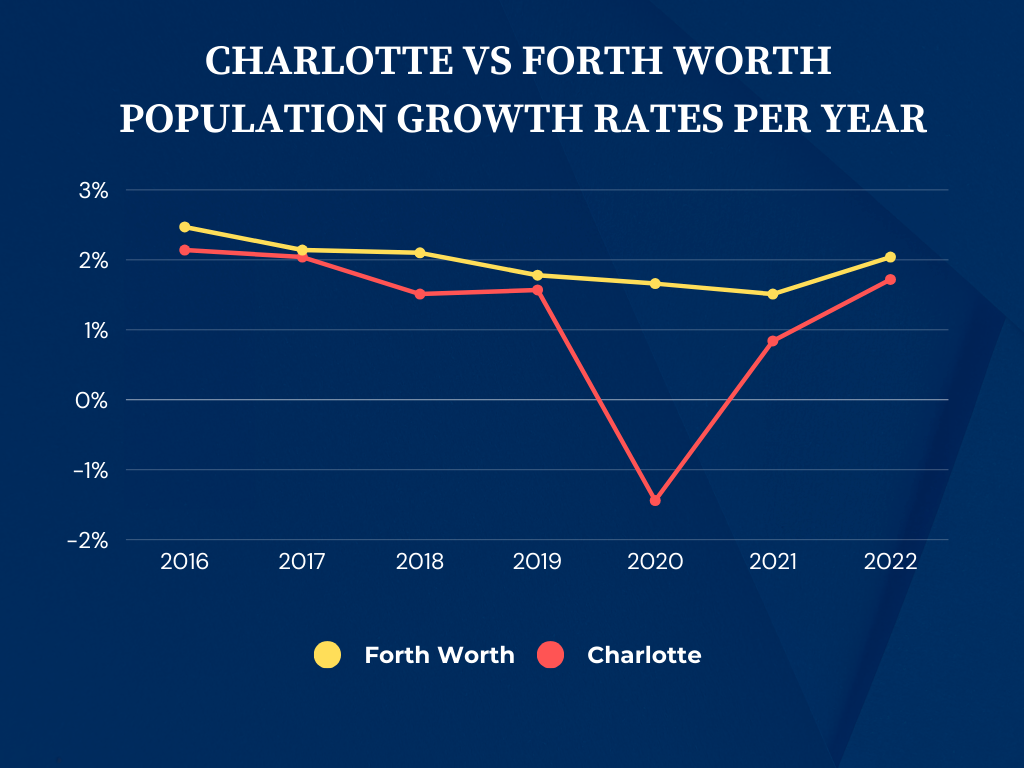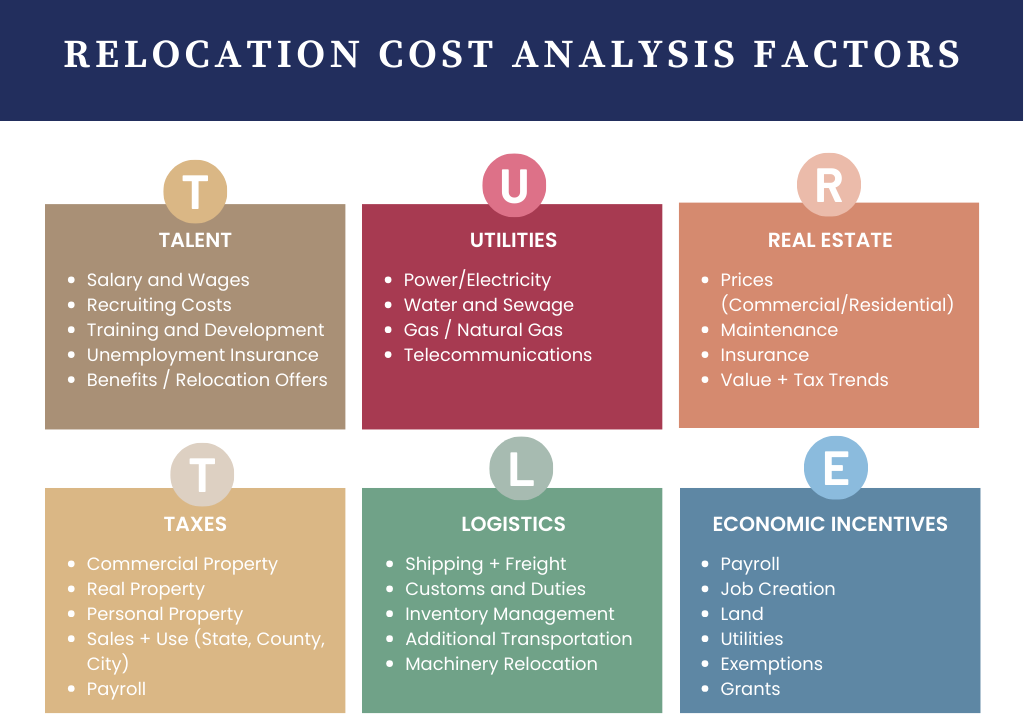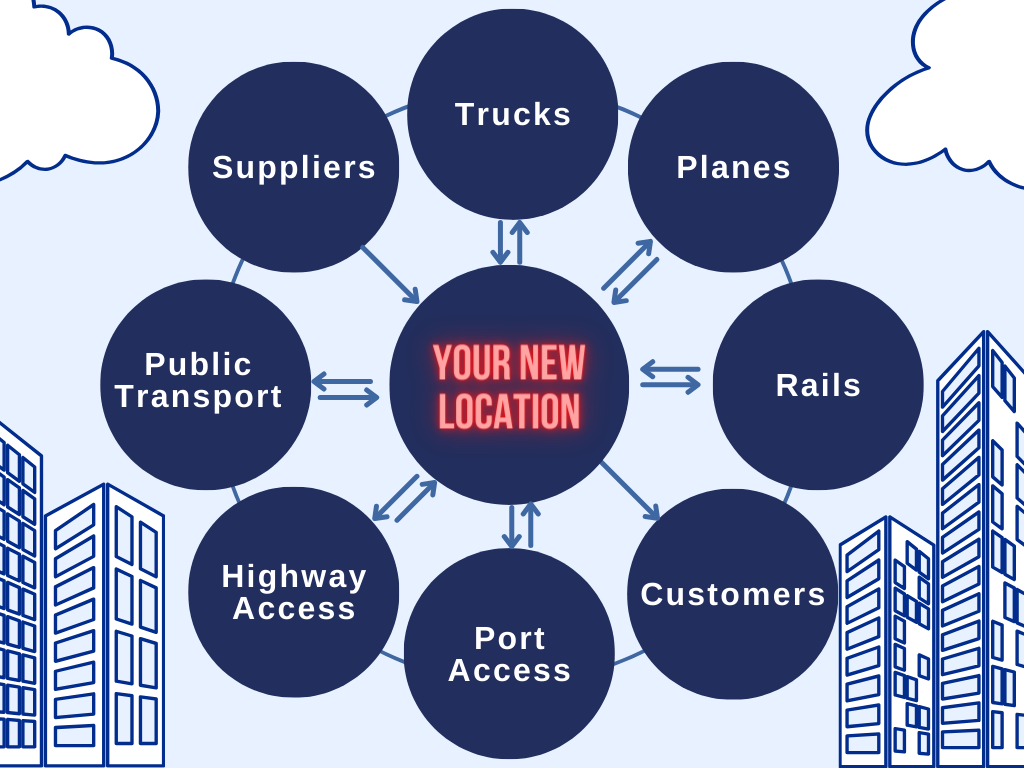
Relocating a business is a complex endeavor. Costs, real estate, navigating unique business environments, and securing the right workforce all play a critical role. This post will guide you through the complex factors, helping you make informed decisions for a successful business relocation. Let's break down what you need to consider and how to manage this major move.
Economic Landscape
Macro Trends: Understanding the big picture of a city or region is the best place to start. Soon, you’ll get into the finite details and costs, but start by understanding the holistic economic landscape. For example: are you interested in the Charlotte region? Did you know that Charlotte is ranked 5th in population increase for cities of more than 50,000 people (US Census Bureau)? Clearly it’s on the rise from a macro perspective.
Macro Factors to Consider:
- Population Growth Rate
- Economic Growth Rate
- Unemployment Rate
- Laborforce Participation Rate
- Population Demographics
- Real Estate Trends
Micro Trends: This is where you identify the details of your move within the context of the big picture. You might know how many people live in Charlotte, but do you know their skillset, average wage, and spending habits?
Micro Factors to Consider:
- Skill Availability
- Wage Costs
- Supply Chain Implications
- Consumer Spending Patterns and Preferences
- Transportation and Logistics
- Real Estate Availability
- Tax Climate
- Incentives
Keep your analysis on the macro and micro factors high level (for now). Reason being, the rest of this article has a section helping you understand these key factors in great depth.
Analysis of Market Trends
Now that you know what factors at the macro and micro level might play a role in your decision, let’s talk about some ways to analyze them. If it’s important that you relocate to a growing city because of labor or customer reasons, you’ll want to understand population growth rates over time.
Try to keep things apples to apples when you analyze cities. For example: it’s not fair to compare the growth rates of Dallas and Charlotte because Dallas is already 50% larger than Charlotte by population. Rather, you can compare two cities like Charlotte and Fort Worth who have similar populations today.
Keep in mind that your decisions shouldn’t just be based on the city you are targeting, but the entire region. Charlotte benefits from 15 counties within it’s region while Fort Worth is part of the Dallas-Fort Worth Metroplex (home to over 7 million people). Use Scout's city exploration platform to find more about each city and region from data, taxes, and reviews from local business leaders.

Chart: Scout | Source: U.S. Census Bureau (Population Estimates Program)
Cost Analysis
The cost of a business relocation project can range from tens of thousands to millions and even billions. That’s obviously an absurd range, but it speaks to the complexity and nuances of these projects. There are far too many factors at play to give an average without context. The infographic below provides a comprehensive list of financial factors that can be added to a cost analysis. Feel free to make your own or download ours. Yes, the acronym is conveniently, TURTLE 🐢.

Source: Scout
Talent and Workforce Considerations
Workforce considerations can be broken down into two segments. Current and future. Current meaning your existing employees and future means those you might hire. Here is what you need to model out for both.
Current Employees:
- Assess retention risks and willingness to relocate.
- Evaluate morale and productivity impacts.
- Will you have the ability or need to replace existing employees with future employees at your new location? Note: This can be a cost driver or saver so look closely.
💡TIP: Keep your project confidential until it is critical you share with all employees.
Future Employees:
- Research labor market and skill availability
- Add salaries, wages, benefits to your cost analysis
- Consider year over year wage growth
- Build a hiring matrix for years 1 through 10 (see below). Ex: new jobs per position for each year in addition the their wages, benefits, and bonuses)
- Analyze new location's attractiveness to potential recruits.
Employee Cost Analysis

Source: Scout | Data for illustrative purposes only
Utilities (Power, Gas, Water)
The availability and cost of utilities at your new location play a crucial role in ensuring smooth operations and future growth. You might find the perfect city and an ideal piece of land, but if the site doesn’t have the power you need or they can’t get it there in time for your move, you’ll need to disqualify it. If your business requires large amounts of power (manufacturing, industrial, cold storage, datacenter, etc…) you’ll want to spend quite a bit of time understanding your requirements. If you’re an office relocation project or retail, you probably care more about cost.
The table below outlines the utility factors to consider for your project.
| Factor | Description |
|---|---|
| Electric | What is your maximum annual demand i.e. 20 Megawatts |
| Load Factor | Average and Peak consumption |
| Reliability Requirements | Most providers have reliability collateral you can read like https://www.duke-energy.com/energy-education/protecting-reliability. |
| Dual Feed Substation | Currently have one? Will you need one? |
| Renewable Attribution | What portion of your power should be attributable to renewables? Is this optional for you? |
| Annual Gas Consumption | i.e. 400,000 therms per year |
| Average Daily Water Usage | i.e. 20,000 gallons per day |
| Average Daily Sanitary Sewer Requirement | i.e. 20,000 gallons per day |
Logistics and Supply Chain
You’ll be doing business in an entirely new place so you’ll want to understand how your supplies flow in and your goods flow out. In distribution center locating there is a strategy called “The Center of Gravity Approach.” The goal is to optimize the distribution center based on the shortest distance between the facility itself, suppliers, and demand.
See why they’re called distribution hubs? They sit in the middle and the spokes flow in from suppliers and out to customers (infographic below). Leveraging GIS technology can be especially helpful in mapping out this critical location factor. Even if your project isn’t a distribution center, the Center of Gravity Approach can be a great starting point for your logistics and supply chain analysis.
Below are the key elements of your logistics and supply chain.
How will your goods flow in and out?
- Nearest rail
- Nearest port
- Closest highway
- Closest airport
- Accessibility by truck and van
Where are your partners?
- Suppliers
- Customers
- Employees
- Transporters
Here’s an infographic that details the Center of Gravity approach.

Source: Scout
Business and Regulatory Environment
The business and regulatory environment is a crucial aspect of any business relocation decision. From understanding the local tax climate to exploring available business incentives and real estate options, there are several key elements you need to consider.
Taxes
- Tax climate (Tax Foundation publishes an annual Business Tax Climate Index you’ll want to review) - we’ve visualized some of their data below in a heat matrix.
- Corporate tax rates and rankings
- Sales and use tax rates
- Property tax rates
Incentives (by type)
You can research on your own or work with a professional incentives negotiator to understand which of these your bossiness might be eligible for.
| Category | Incentive/Grant |
|---|---|
| Tax Credits and Exemptions | Corporate Income Tax Credits |
| Tax Credits and Exemptions | Property Tax Abatements |
| Tax Credits and Exemptions | Sales Tax Exemptions |
| Tax Credits and Exemptions | Research & Development Credits |
| Tax Credits and Exemptions | Investment Tax Credits |
| Tax Credits and Exemptions | Opportunity Zone Benefits |
| Grants and Funding | Job Creation Grants |
| Grants and Funding | Training Grants |
| Grants and Funding | Infrastructure Improvement Grants |
| Grants and Funding | Technology Innovation Grants |
| Grants and Funding | Export Assistance Programs |
| Specialized Incentives | Renewable Energy Incentives |
| Specialized Incentives | Opportunity Zone Benefits (again) |
Below is a heat matrix that showcases the "Overall Rank," "Corporate Tax Rank," and "Sales Tax Rank" for each city in the US. Each matrix is arranged according to the specific ranking category, allowing for a clear comparison of states in terms of their overall tax climate, corporate tax, and sales tax. The color gradients indicate rank, with cooler colors for better rankings and warmer colors for lower rankings.



Charts: Scout | Source: Tax Foundation 2024 State Business Tax Climate Index. The charts shows tax systems as of July 1, 2023 (the beginning of Fiscal Year 2024).
Site and Facility Requirements Checklist
Here’s a checklist of requirements you’ll want to understand as you start to look at sites or facilities.
- ✅ Total Land Requirement
- Assess the total land area needed for operations.
-
✅ Building Size
-
If an existing building is available, specify required size.
-
-
✅ Preferred Site or Building Configuration
-
Detail desired shape, examples, utility access, dock heights, etc.
-
If office, specify: class A, B, or C
-
-
✅ Zoning Requirements
-
Identify necessary zoning types (e.g., Industrial, Commercial).
-
Note specific requirements like Heavy or Light Manufacturing.
-
Consider building height restrictions.
-
-
✅ Operations Schedule
-
Define operational frequency (e.g., weekdays, 24/7).
-
Personal Considerations
You must consider factors that effect your employees and their families. Here are a few of the top factors to think through.
Crime Rate: Understanding the safety of a neighborhood where your business is located and where your employees live is paramount. Researching local crime statistics and safety reports can provide insight into the security of the area.
Education System: For families with children or those planning to start a family, the quality of local schools is a vital factor. Investigate public and private school options, their ratings, and the overall education system.
Home Values: Home values not only affect the cost of purchasing property but also reflect the area's economic health. Analyze the current real estate market, trends in home values, and future projections.
Cost of Living: This encompasses the overall affordability of the area, including utilities, groceries, transportation, and healthcare costs. A higher cost of living can significantly impact employee decisions to move or to work for your company.
Quality of Life: Often subjective, this includes factors like climate, recreational opportunities, cultural offerings, and community engagement. It's about the overall satisfaction and well-being you and your family would experience in the new location.
Relocation Risks
You might be moving your business to take advantage of cost savings, more sales, or higher efficiencies, but it’s all for not if you don’t consider the risks involved. We recommend stack ranking the following 10 risks prior to making your final decision. You’ll never be able to eliminate risk entirely, but naming them and coming to terms with them will help you feel more confident in your decision.
- Market Stability Risks: Changes in local market conditions, economic downturns, or shifts in consumer behavior.
- Operational Disruption Risks: Challenges during the transition period, including disruptions in production or service delivery.
- Regulatory and Compliance Risks: Local laws, regulations, and compliance requirements that might differ from your current location.
- Supply Chain Risks: Potential disruptions or inefficiencies in supply chains, including changes in supplier relationships or their location.
- Employee Retention and Recruitment Risks: Challenges in retaining key staff during moving and recruiting new talent in the new location.
- Utility Risks: Inadequacies in mission critical utility providers such as amount of power or time to deliver said amount of power.
- Environmental and Climate Risks: Hurricane, Earthquake, Tornado, Wildfire, Severe Weather, climate change effects, or environmental regulations impacting the business.
- Political and Economic Policy Risks: Political instability or unfavorable economic policies that could affect business operations.
- Local Reception: Think Amazon HQ2 and how local activism played a large role in squashing the project. Does the public want you there as much as the state and local government does?
- Brand and Reputation Risks: Impact on brand perception and reputation due to relocation, potentially affecting customer loyalty and market position.
This infographic is a good reminder of the top risks associated with moving a company.

Conclusion
Embarking on the journey of expanding or moving your business is more than a physical move; it's a strategic decision that demands deep consideration for people and process. Key areas for assessment include:
- Economic Landscape (macro / micro)
- Analysis of Market Trends
- Business Relocation Cost Analysis
- Talent and Workforce Considerations (current / future employees)
- Utilities
- Logistics and Supply Chain
- Business and Regulatory Environment (taxes / incentives)
- Site and Facility Requirements
- Personal Considerations
- Risks
As you’ve learned in this article, each of these factors isn’t just a factor of one. It’s a set of complex variables that make up an extremely important decision for companies and employees alike. A business relocation can be transformative for businesses, shareholders, workers, suppliers, providers, local economies, state economies, and much more. By learning and honoring the complexities of this process, you’re on the way to making a great decision for all your constituents.



